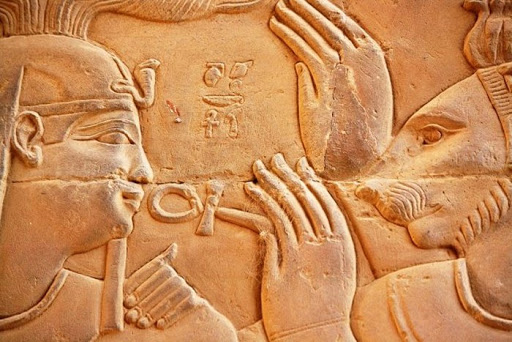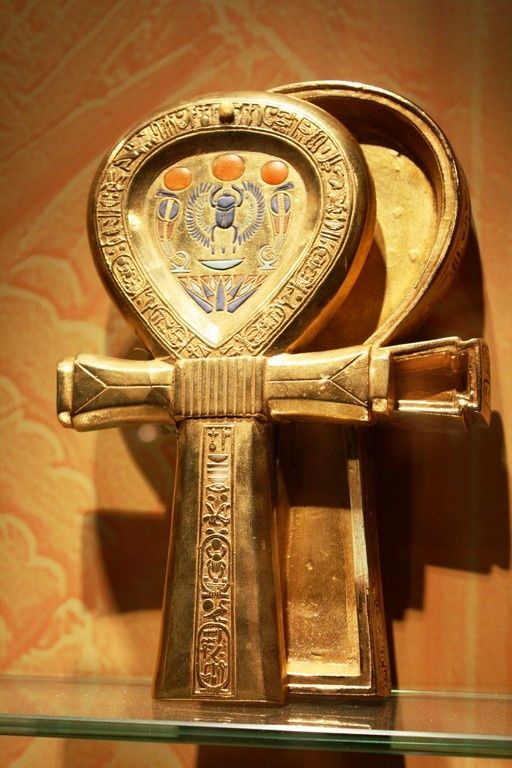ANKH, ANKH MEANING, EGYPTIAN ANKH
Origin & Meaning
The Ankh is one of the most recognizable symbols from ancient Egypt, often referred to as “the key of life” or the “cross of life”. This ancient symbol dates back to the Early Dynastic Period (c. 3150 – 2613 BCE). It appears as a cross with a loop at the top and is usually depicted as a simple gold cross, though sometimes adorned with symbols or decorative elements. The ankh is an Egyptian hieroglyph for “life” or “breath of life” (`nh = ankh), reflecting the Egyptian belief that earthly life was just a part of an eternal existence. Thus, the ankh symbolizes both mortal life and the afterlife.

The exact origin of the ankh remains uncertain. Egyptologist Sir Alan H. Gardiner proposed that it evolved from a sandal strap, with the loop representing the ankle and the vertical post the sole. This theory, based on the similarity of the word “sandal” (nkh) to “ankh”, suggests that because sandals were essential in daily Egyptian life, the ankh symbol naturally came to represent life itself. However, this idea has not gained wide acceptance.
Another theory by Egyptologist E.A. Wallis Budge posits that the ankh originated from the belt buckle of the goddess Isis, known as the “knot of Isis” or tjet, a ceremonial girdle symbolizing fertility. Budge associated the ankh with the tjet, suggesting it represented female genitalia and fertility, aligning with the ankh’s broader symbolism of life and eternal life. This theory is supported by Egyptologist Wolfhart Westendorf, who noted the similarities between the ankh and tjet and their early use in Egyptian history.
Scholar Adele Nozedar has written extensively about the rich and layered symbolism of the ankh. She explains that the ankh represents male and female genitalia, the sun rising over the horizon, and the union of heaven and earth. Traditionally drawn in gold to represent the sun, the ankh is never depicted in silver, which is associated with the moon. The resemblance of the ankh to a key further highlights its role as a symbol of life and the afterlife, believed by the Egyptians to be as significant as earthly life.
The Ankh & The Goddess Isis
The ankh became widely used during the Early Dynastic Period, particularly with the rise of the cults of Isis and Osiris. Early images of Isis with the tjet girdle support the association of the ankh with the tjet. The cult of Osiris, which celebrated the god who died and was resurrected, was initially the most popular in Egypt. Over time, the cult of Isis, which shared similar stories and promises of resurrection and eternal life, became dominant. Isis, originally a mother goddess associated with fertility, became known as the devoted wife of Osiris, who resurrected him after his murder by Set.

As the most popular goddess in Egypt, Isis was frequently depicted holding the ankh. Her worship overshadowed that of Osiris, and the ankh’s association with Isis gave it additional significance as a symbol of eternal life and divine protection. The ankh’s prominence in tomb paintings and inscriptions, where gods like Anubis or Isis are seen placing the ankh against the lips of the deceased to revitalize them, underscores its role in the afterlife. The goddess Ma’at and the god Osiris are also frequently depicted holding the ankh, further cementing its association with life and the afterlife.
The History of the Ankh in Use
The ankh’s symbolism was easily recognizable, even to those who could not read. While it was not exclusively associated with Isis, as many gods are depicted carrying it, the ankh became more closely linked to Isis over time, much like the djed symbol became associated with Osiris. By the Old Kingdom (c. 2613 – 2181 BCE), the ankh was firmly established as a symbol of eternal life. The deceased were referred to as ankhu (having life/living), and caskets and sarcophagi were often decorated with the ankh and known as neb-ankh (possessing life).
During the Middle Kingdom (2040-1782 BCE), the word nkh was used for mirrors, and many hand-mirrors were crafted in the shape of the ankh. The most famous of these is the mirror found in the tomb of Tutankhamun. This association was not coincidental, as the Egyptians believed the afterlife was a mirror image of life on earth, and mirrors were thought to have magical properties. During the Festival of the Lanterns for the goddess Neith, Egyptians burned oil lamps to create a mirror image of the heavens on earth, hoping to communicate with deceased loved ones.
The ankh was also a popular amulet worn in life and placed in graves. Historian Margaret Bunson notes that these amulets, called wedjau, were made from various materials and believed to hold magical powers. They provided supernatural benefits and protection, worn as pendants by the living and placed among the wrappings of the deceased.
The ankh’s significance continued through various periods of Egyptian history. During the New Kingdom (1570-1069 BCE), the ankh became associated with the cult of Amun and was prominently used in temple ceremonies. Even during the Amarna Period (1353 – 1336 BCE), when Akhenaten banned the cult of Amun and other gods, the ankh remained in use, symbolizing life through the beams of light from the solar disc of Aten. After Akhenaten’s death, his son Tutankhamun restored the old religion and retained the ankh’s significance. The ankh remained a powerful symbol throughout Egyptian history, used by rulers like Ramesses II (1279 – 1213 BCE) and continuing to appear in inscriptions and tombs.
The Ankh & Christianity
As Christianity gained acceptance in the 4th century CE, many symbols of the old Egyptian religion fell out of favor or were banned. However, the ankh remained in use. Scholar Jack Tresidder describes the ankh as symbolizing various concepts such as the rising sun, the union of male and female, and the key to esoteric knowledge and the afterlife. The Coptic Church of Egypt adopted the ankh as a form of the Christian cross, symbolizing eternal life through Christ.

Adele Nozedar notes that powerful symbols often cross cultural boundaries, and the ankh is no exception. Its symbolism of immortality and the universe was embraced by 4th-century Coptic Christians to reinforce Christ’s promise of life after death. Over time, the ankh evolved into the Christian cross, retaining its association with life and the promise of eternal life. Today, the cross is worn by believers in Jesus Christ, much like the ancient Egyptians wore the ankh, as a symbol of faith and divine promise.